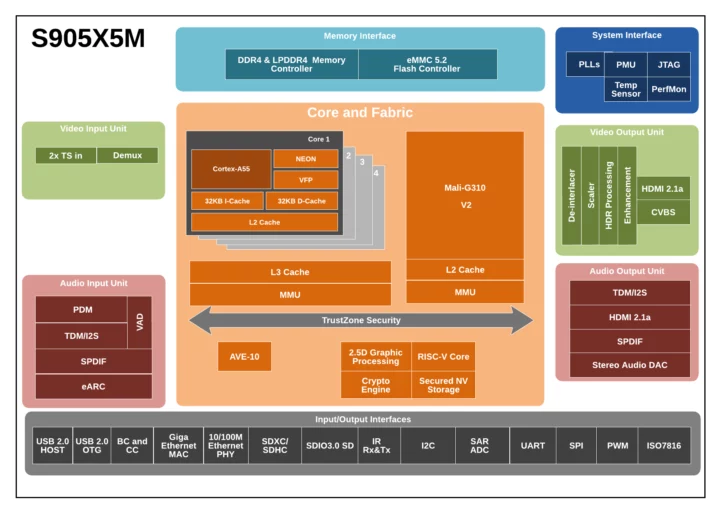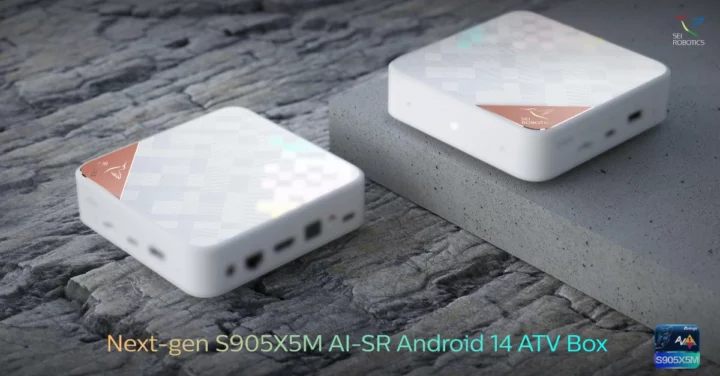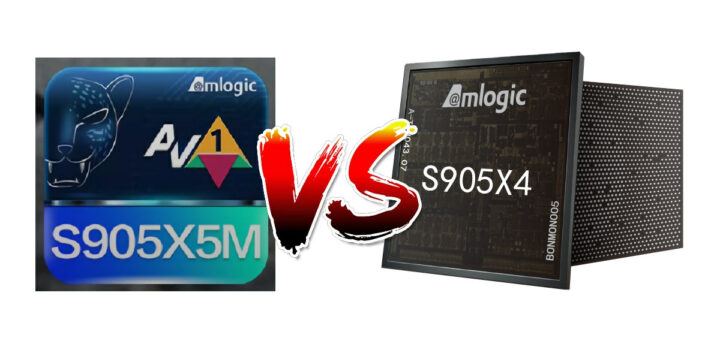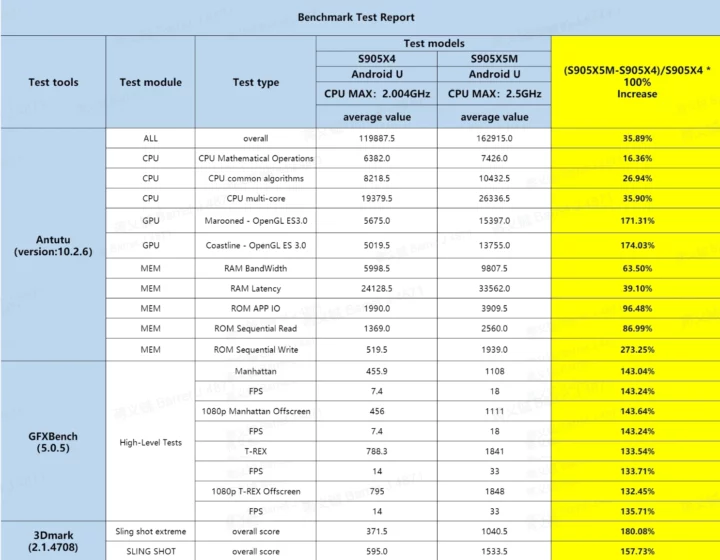Amlogic S905X5M is an update to the Amlogic S905X4 quad-core Cortex-A55 SoC with a higher 2.5 GHz CPU clock and a new generation Arm G310 CPU that delivers up to close to three times the performance of the Mali-G31 MP2 GPU for more advanced and smoother HDR user interfaces.
The S905X5M and S905X4 share the same video decoding capabilities, notably AV1 and H265 up to 4Kp75, but the new S905X5M drops support for H.265 1080p60 video encoding, only keeping H.264 1080p30. One of the new features is the inclusion of an NPU designed specifically for Super Resolution enabling video upscaling with better image quality. You’ll find the differences between the Amlogic S905X5M and S905X5 processors in the comparison table below.
Amlogic S905X4 | Amlogic S905X5M |
|
|---|---|---|
| CPU | Quad-core Cortex-A55 up to 2.0 GHz | Quad-core Cortex-A55 up to 2.5 GHz |
| GPU | Arm Mali-G31 MP2 | Arm Mali-G310 V2 with HDR UI support |
| Neural network accelerator | N/A | inline AI-SR (AISR2) |
| Memory | 32-bit DDR3/3L/4, LPDDR3/4 Up to 4GB, DDR3200 | 16/32-bit DDR4/LPDDR4 up to 4GB, DDR3200 |
| Storage I/F | eMMC 5.0, NAND Flash, SD | eMMC 5.2 with HW CQ & inline encrupt, SLC/QSPI NAND Flash, SD |
| Video Output | HDMI 2.1b 4Kp60 output with ALLM, eARC, CVBS | HDMI 2.1b 4Kp60 output with ALLM, eARC, QMS, VRR, QFT, SBTM, CVBS. |
| HDR | HDR10/10+, HLG, Dolby Vision(Opt), TCH PRIME | HLG/HDR10/ 10+ Dolby vision |
| Audio | Stereo DACs, S/PDIF In and Out, 8-ch PDM, 12-ch I2S in, 12-ch I2S out | Stereo DACs, S/PDIF In and Out, 4-ch PDM, 8-ch I2S in, 8-ch I2S out |
| Video Decoding | 4Kp75 10-bit: AV1, H.265, VP9, AVS2; 4Kp30: H.264 |
|
| Video Encoding | 1080p60 H.265/1080p30H.264 | 1080p30 H.264 |
| Voice & Audio Processing | VAD, ASRC/EQ/DRC, HiFi4 audio DSP | VAD, ASRC/EQ/DRC |
| DRM & CAS | Widevine, PlayReady, VMX, TKL C2: Irdeto MSR4, Nagra NOCS3.2, NDS NSK2, VO | Widevine, PlayReady, VMX, TKL |
| Ethernet | Gigabit Ethernet MAC, and 10/100M PHY |
|
| USB and PCIe | 1x USB 2.0 OTG + 1x USB 3.0 or PCIe v2 + 2x USB 2.0 (OTG. Host) | 2x USB 2.0 (OTG, Host), USB-C CC |
| Crypto Engine | AES, TDES, SHA-1/SHA-2/HMAC, RSA | AES, TDES, SHA-1/SHA-2/HMAC, RSA, ECC Crystal-Dilithium PQC engine |
| DVB | 4x Transport Stream (TS) inputs, ISO7816 smart card standard |
|
| Package | 14x14mm BGA | 13.3x11mm BGA |
| Manufacturing process | 12nm | 6nm |

The Amlogic S905X5M adds some HDMI 2.1 features that deserve an explanation:
- QMS (Quick Media Switching) – A source device can instantly switch its content’s resolution or frame rate without any display blackout, for example, when switching from 60 Hz to 24 Hz to watch a movie.
- VRR (Variable Refresh Rate) – Syncs up source and display with continually changing refresh rate, up to a frame-by-frame basis in order to reduce or eliminate interaction lag, stutter, and tearing.
- QFT (Quick Frame Transport) – Each video frame travels faster from the source even though the source does not increase its frame rate. This reduces lag for gaming and real-time interactive interfaces
- SBTM (Source-Based Tone Mapping) – Enables the source to send a video signal that takes full advantage of a specific display’s HDR capability by adjusting its output to take better advantage of each display’s features.
The Amlogic S905X5M also loses some features such as TCH PRIME DRM, the HiFi 4 audio DSP, and the USB 3.0/PCIe Gen2 interface. The latter is unlikely to be an issue for TV boxes and set-top boxes, but it’s disappointing for alternative use cases like single board computers. Note the Amlogic S905X5M is not to be confused with the more powerful Amlogic S905X5 SoC unveiled last year, and which is now scheduled to launch in about two months, according to SEI Robotics that provided the information above, along with the S905X4 vs S905X5M benchmarks comparison table below.
Android U refers to Android 14, and all benchmarks (Antutu 10.2.6, GFXBench 5.0.5, 3DMark 2.1) include 3D graphics tests showcasing the much higher performance of the Arm Mali-G310 V2 GPU that ranges from 132.45% to 180.08% increase in performance, or between 1.36 to 2.8 times faster. CPU performance has also increased by 16 to 36%, and memory bandwidth is much higher as well despite no big changes listed in the specifications provided by the company. The video below is supposed to show how the UI on the right (S905X5M) is rendering more smoothly than the UI on the left (S905X4), but I’m not 100% convinced that’s the best demo for the new GPU…
SEI Robotics will be one of the first companies to launch an Amlogic S905X5M powered TV box running Android 14 TV and implementing the new features listed above such as AI-SR, QMS, a faster user interface, Doby Audio, Dolby Vision, eARC, and so on.
Note the company is an ODM working with operators so that specific model will not be directly sold to individuals, but it will become available in September through three tier 1 operators which are unnamed in the press release.


Jean-Luc started CNX Software in 2010 as a part-time endeavor, before quitting his job as a software engineering manager, and starting to write daily news, and reviews full time later in 2011.
Support CNX Software! Donate via cryptocurrencies, become a Patron on Patreon, or purchase goods on Amazon or Aliexpress






I’ve just seen that S905X5M is pin-to-pin compatible with S905Y5 (DDR4/LPPDR4 designs) and S905Y4 (only for DDR4 designs)
I was wondering why no A510, but I found the talk of it not being any better than A55 back when it was released, and it was 64-bit-only on release. However there was a nameless refresh of the core that added 32-bit capability and supposedly improved efficiency. A520 goes back to being 64-bit-only.
That’s an interesting chip, especially with the massive GPU improvement. Maybe it could end up in a retro handheld. Shame for losing USB3 though.
There are two (three) parts:
Amlogic S905X5M – Quad-core Cortex-A55 processor with 30K DMIPS (apparently available now)
Amlogic S905X5 (and S905C5) – Quad-core Cortex-A510 Armv9 processor with 40K DMIPS (available in Q4 2024)
It’s sad that after all these years they continue to confusingly call all their SoCs S905 with a bunch of varying letters. Thinking that S905X5 is Armv9 and S905X5M is Armv8 is really getting totally ridiculous. They should fix their keyboard for the missing digits and letters. In 10 years, their Armv10 version will be called S905X5M3AB2, that’s really pathetic. I really don’t understand the value in making so confusing names. It hides the value of their products because one only remembers “S905” or “S905X” and not the following details.
> they continue to confusingly call all their SoCs S905 with a bunch of varying letters
Nope, they also use 928, 922, 912, 812, 805 and 802 with the letter S and managed to combine the letter A with 113 and 311 (makes it easier to confuse both). Prefixed with T it gets crazy since the 905 equivalent is 962. But A and T don’t matter.
They reuse the S905 string due to reviews (or due to of what marketing department thinks of consumers). Consumers are not interested in or able to understand details as such once you established a successful product name containing ‘S905’ you stick with it since… consumers (not you or the other 9 people on this planet trying to understand Amlogic naming)
Yes I know this but given how bad the original S905 and even worse its S905X successor were, current models have nothing to do with these turds anymore and it’s easy to see such old reviews and think “the new one cannot be much different”.
A retro handheld based on S905X5M may be a good idea. Besides the faster GPU, the company also claims around 57% lower power consumption (at the same 1.7GHz), so that could make sense.
One potential issue I see with S905X5M in a handheld is its lack of any LCD interface (RGB/MIPI). Designers would either use SPI (slow, not really suitable for gaming handheld) or bridge from HDMI (potentially higher power consumption)
> the company also claims around 57% lower power consumption (at the same 1.7GHz)
Based on a joke called Dhrystone ‘benchmark’ that represents exactly 0% of today’s code on these thingies.
While dhrystone is totally irrelevant to nowadays code, at least it directly depends on the frequency and IPC for simple instructions. It gives an indication of the number of parallel instructions issued in the CPU and allows to distinguish an A55 from an A72 or A76 for example. It’s not an indicator of performance but rather of core complexity. If one vendor would optimize for dhrystone it wouldn’t make any sense, just like measuring that to gauge machine performance. But seeing a 33% gain in dhrystone over an A55 makes me think the cores switch from a dual-issue to triple-issue… Read more »
Does any of the variants S905X5M, S905X5 or S905C5 have MIPI-DSI?
I can see MIPI CSI for camera(s), but not MIPI DSI.
The Amlogic A311D3 will have “multi-panel output”, but I suppose it would be quite pricey for a handheld console.
I only know the S922X/A311 (which already exists in handheld gaming devices) and A311D2 which has hdmi input and myriad MIPI-C/DSI this is definitely overkill for handhelds. Do you have any more info on A311D3?
Nothing much:
It’s an update to S928X scheduled for H2 2024.
I do think that the backward step of only providing 2x USB 2.0 will have an effect on Android TV boxes because of the lack of ability to hook up just one reasonably fast external storage option.
So I expect this SOC to perhaps make it’s way to more of the ‘officially Google supported’ boxes dedicated to streaming.
But as far as the no name brands, I think this will have a negative effect on sales and will doubt be one definite criticism from reviewers.
The ‘stick’ type STBs tend to have a micro-USB for storage, don’t they? I guess the modern ones should have USB-C which could support 3.0. Not sure how much of an issue this is going to be in the part of the market for which it’s intended.
I think some of the differences in bold should disappear, right? At least some of the DRM related ones. If not, why would they downgrade the chipset? Storage wise having USB 2.0 is a bad idea, even on stick format devices.
I’m not sure why but that’s the info I was given. Maybe it’s not ready yet.
If I understand correctly:
S905X5 -> Quad A510, G310v5, 6nm, PCIe-3.0, USB3.0, LPDDR5-6400, 4TOPS NPU, HIFI5 DSP, H266 4K@60fps decoder , H265 4K@60fps encoder, Gbit ETH.
S905X5L -> Everything same as S905X5 but LPDDR4 – 3200 and 3.2TOPS NPU.
S905X5M -> Quad A55 , G310v2, 6nm, no PCIe, USB2.0, LPDDR4-3200, no NPU, H265 4K@60fps decoder , H264 1080p@30fps encoder, Gbit ETH.
I have no information about S905X5L. Do you mean S905X5C?